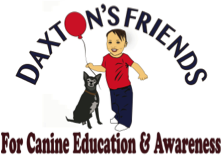 What are the signs that a dog may be on the verge of biting? Many dogs show one or more of these signs prior to biting:
What are the signs that a dog may be on the verge of biting? Many dogs show one or more of these signs prior to biting:
- “freezing” in place
- showing the whites of the eyes
- aggressive vocalizing (growling, snarling, barking aggressively)
- lifting/curling lips
- lunging
- snapping
- “nipping”(a “nip” that does not break the skin is still categorized as a mild bite and may quickly escalate to a more serious bite)
The following are situations where aggressive (or potentially aggressive) dogs are likely to show the signs above:
- Dog being approached while eating or chewing a toy/treat
- Dog being removed from furniture
- Dog being petted or having a collar or leash put on
- Dog being hugged or kissed
- Dog and child playing together
- Dog is leashed or confined in yard when others pass by
- Dogs being fed at the same time
- Dogs trying to pass through a narrow doorway at the same time
- Reaction to a person entering the room
Owners often have two reactions to their dog’s aggression issues, some try to reason as people while others are in denial. Very few owners can recognize the signs of aggression in order to make logical and appropriate decisions. The owners that reason with their dogs as people often say things such as “Don’t growl at mama” or “Just ignore Rover, he doesn’t mean it”. There are owners that see their dog as another person and do not acknowledge that dogs are animals with animal instincts. Instinctual reactions are not the same as human reactions. The owners in denial often understand, deep down, that their dog has aggression issues, but refuse to acknowledge them. They don’t want to address aggression or hear others address it.
There are those that can become quite defensive when someone points out their dog’s behavior. They just want to wait it out and hope the dog corrects its own behavior. Some owners understand the risks and dangers of aggression and responsibly take steps to modify or control the problem. Aggression cannot be “trained” out of a dog. Depending on the type of aggression, behaviors can sometimes be modified or controlled, such as feeding a food aggressive dog in another room. Sometimes “triggers”, which may cause a dog to act aggressively, can be avoided. For example, an owner of a dog aggressive dog can avoid contact with other dogs by having a secure fence, avoiding dog parks, and wearing a muzzle in public. Even though some trainers claim to be able to train the aggression out of a dog, most fall short of this claim. A dog that dislikes children cannot be trained to like children. A dog that is dog aggressive cannot be trained to have a positive reaction to other dogs. Trainers and behaviorists can be consulted for minor aggression issues and, in that capacity, may be able to help. Trainers are not miracle workers and if the claims sound too good to be true, they probably are. Most trainers do not offer a money back guarantee.
Some dogs display unpredictable aggression. This type of aggression often does not have a cause or trigger. It can appear suddenly and out of nowhere. While any dog can have this type of aggression, there are certain breeds of dogs that are more prone to it. The majority of these breeds fall in the fighting breed category. It is recommended that dogs displaying this type of aggression be humanely euthanized. Owning a dog that has unpredictable aggression is a personal and public safety risk, especially if the dog is large enough to inflict serious injury or death to a person or other animal.
Puppies are not a clean slate. They are a product of their breeding and genetics. It is commonly thought that puppies can be molded into the perfect dog. Proper socialization and positive experiences can affect puppies, but genetics always trumps everything. There are many cases of puppies being raised well, but still have behavioral or aggression issues. Dogs that have aggressive parents are more likely to be aggressive as they mature. A puppy’s personality at 2-3 months of age is not always a good indication of what they will be like as an adult. If possible, meet the parent dogs and observe them for signs of aggression. Many dogs will not show their true personalities until they are 1-3 years in age and fully mature.
Puppy owners often ignore signs of aggression because puppies are small and cute. A puppy that is protecting its food bowl with snarls and growls will grow into a strong adult dog that can cause significant injuries. It is important to deal with aggressive behaviors as soon as they arise because aggressive dogs can be highly dangerous. It is best to start with a visit to a veterinarian to rule out any medical reasons that may be causing the aggression. If the veterinarian gives a clean bill of health, then it may be time to consult a trainer/behaviorist that is experienced with dogs with that particular type of aggression. The trainer may be able to give tips on how to avoid or deal with the aggression issue. Since aggression cannot be trained, there is always a possibility that the dog can cause harm to a person or an animal. It is perfectly acceptable to not want to keep an aggressive animal, especially in homes with children. It is appropriate to rehome the dog as long as you disclose to the new family the behavior issues and history. There are times that humane euthanasia is the best option for public safety.
Click here to learn more about the different types of dog aggression
